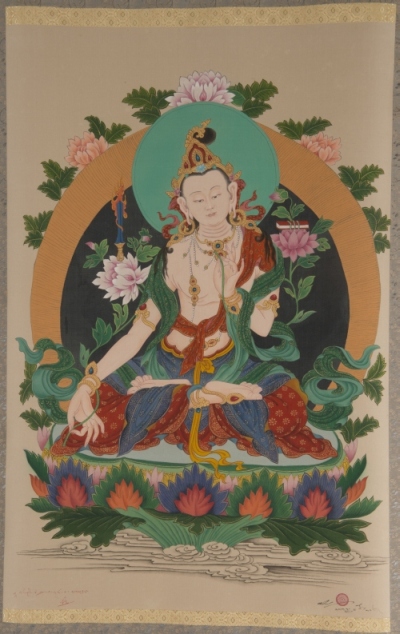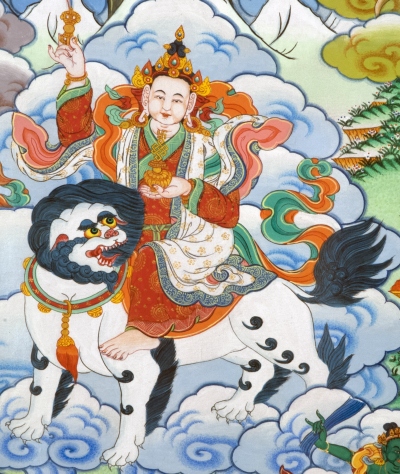Some years ago, HH Dalai Lama surprised many at a meeting in Dharmsala by
stating quite clearly that he did not believe in astrology, that it did not
work. This meeting took place at the Tibetan Medical and Astro
Institute and I am told that a significant proportion of the astrologers present
subsequently gave up astrology and found new careers.I do not wish to try and guess the Dalai Lama's intentions and reasoning here, but instead consider the position of astrology within Buddhism and what might be the best Buddhist approach to the subject. When I first heard of the Dalai Lama's comments, my immediate reaction was to state that Tibetan astrology could not possibly work given the huge inaccuracies in the calendar on which it is based. But even if the calendar were reformed, might Tibetan astrology "work", and what would be meant by that? Since Jung, the first major modern attempt to take an objective approach towards astrology was published in the 1977 book, "Recent advances in natal astrology", by Geoffrey Dean. A telling comment early in the book is this: "The picture emerging suggests that astrology works, but seldom in the way or to the extent that it is said to work." There are two points in that sentence: first, that astrology appears to work, and second, but not in the way expected. On the first point, all too often simple gullibility is the reason that people think that astrology "works". The same book describes surveys in which, for example, newspaper adverts invited people to send in their birth details, they would then receive a reading, and would be asked to comment on its accuracy. They were all sent the same reading, and yet, in one case, 94 per cent said the fake horoscope accurately described their character. There have been several such experiments, with broadly similar results. This is the first difficulty in assessing astrology. Users and practitioners of astrology should be extremely wary of confirmation bias. The second point poses the question of just what people's expectations are of astrology, and the way it is expected to work. A problem lies in the fact that people have a different attitude towards astrology than towards other forms of divination – they seem to assume or expect some form of causality. One form of divination commonly used by Tibetans uses a māla, a rosary of beads: applying a particular meditation and considering the question, the practitioner grasps the beads at random and counts inwards, usually in threes, until arriving at a number of beads between one and six (a die can also be used). This number is the result of the divination and forms the basis of the prognosis that is given. Does anybody ever think that the resulting number causes the future that is then foretold? Of course not. Take a western example: tea leaves. In the days before tea bags, the tea leaves at the bottom of a finished cup would be swirled around, and quickly turned upside down into the saucer. Many leaves would stay in the cup, sticking all around the inside. From patterns formed in the cup, suggesting perhaps images or letters, the prognosis would be divined. Again, nobody in the their right mind would consider that the patterns of the tea leaves caused the future predicted events. And yet with astrology, the whole grammar that has grown up around the subject suggests exactly some form of causality: "I am aggressive, because I am an Aries", and so forth. This grammar, this way of thinking and talking about astrology, tends to lead to a certain suggestion of inevitability, of fatalism, even; a direct causality. But this is not the view within Buddhism. Of all Buddhist texts, the one most closely associated with astrology and the philosophy behind it is the Kālacakra Tantra and its commentary, the Vimalaprabhā. The latter says this, quoting the Kālacakra Mūlatantra: "Ultimately, all good and bad (results) are determined by one's actions. Regarding this: 'For all weekdays, lunar days, mansions and yogas, karaṇas, ascendants and evil planets, good will result when virtue is practised. Beings born in the same moment will have different lives and different outcomes; dependant on their individual actions, they will not have the same result. As a result of [for example] battles, forest fires and catchment in fishing nets, many beings come to die at the same time. The virtues of beings create strong life, effort, power and fortune, and their evils weaken life, effort and power.'" Is this not a clear statement to the effect that astrology, as it is normally understood, simply does not work? Your future is not "written in the stars". The important point here is that although the horoscope does not determine a person's future, it can perhaps be suggestive of that future, indicating the potential of that individual. This is more like a general system of divination, and in fact the use of astrology for natal astrology was a late development in its history. The first uses of astrology were in horary astrology, where a question is asked; usually the horoscope is drawn up for the time when the astrologer is asked the question. No causality is suggested here – the position of the planets at that time could not be thought to cause the ensuing result; they more indicate, suggest, the answer. This places horary astrology in exactly the same position as any other system of divination; it follows that natal astrology, the later development, should be viewed in the same way; it is non-causal. So, what is the connection between the planets and our lives? Chogyam Trungpa Rinpoche called it the maṇḍala principle and Jung called it synchronicity, an "acausal connecting principle"; the point being that there is a meaningful relationship between otherwise non-causally connected events.
Also, the quotation is misleadingly incomplete, and should read: "As outside, so it is within the body, so it is with other, in the powder maṇḍala." ( ji ltar phyi rol du de bzhin lus // ji ltar lus la de bzhin gzhan // rdul tshon gyi ni dkyil 'khor la'o //). The quote concerns the symbolism of the maṇḍala and the fact that the meditation on the maṇḍala purifies the experience of both the inner and outer worlds. It does not say that the outer world causes the experiences of the inner world, but states that there is a correlation between the two. This is an important distinction. An almost identical quotation is also to be found in the Kālacakra text, the Śrīmadvimalaprabhātantrāvatāraṇīvāda hṛidayāloka, ( dpal ldan dri ma dang bral ba'i 'od kyi rgyud la 'jug pa'i bshad sbyar mi g.yo ba'i snying po snang ba): "As outside, so in the body; as in the body, so with other." (ji ltar phyi rol de bzhin lus // ji ltar lus la de bzhin gzhan //). This is explained in that text as concerning the vajrakāya and the maṇḍala, not astrology. From the point of view of the maṇḍala principle or synchronicity, the relationship between the planets and our lives becomes fuzzy, vague and open to interpretation. If this were not the case, and there was literal causality involved, somebody would by now have developed very accurate horoscope software. The interpretation of any form of divination, from māla beads and tea leaves to an astrological horoscope, depends on human interpretation and experience, and, from a Buddhist point of view, and most importantly, intuition. I mentioned above that a Buddhist divination is performed with a particular meditation. The meditation involved usually relies on Mañjuśrī or one of the protective deities. Part of the intention is to create a mental state conducive to the occurence of meaningfully related events. Consider the verse recited with Tashi Tsheringma (bkra shis tshe ring ma) divination:
As Jung might have put it, the mention of dependant origination is no less than a direct appeal to synchronicity. The other purpose of the meditation is, of course, to open the mind to its intuitive faculty. A simple number between one and six hardly reveals much information as an answer to a question; the further details in an answer can only come from the intuition of the diviner, provided that person has developed their intuition through meditation practice. Perhaps this suggests one of the problems with astrology – it is far too complex. With the western system there are the planets, signs and houses, and large numbers of aspects (particular angles between planets) that can be considered, including those between progressed, transiting and natal planets. There is also much more. The Tibetan system combines methods from India and China: from India, there are not only the planets, signs, houses and their various yogas (combinations), but also the five components of the calendar: weekdays, lunar dates, lunar mansions, yogas and karaṇas; from China there is the whole system of elemental divination (it is not really astrology, but is easily combined with astrology), including the five elemental transformations, 12 animals, eight trigrams, nine numbers and other cycles. All that complexity must surely be revealing important information? Well, no. It is very easy to be distracted by all these details, with all this rich and seductive symbolism, believing that they mean something, that they are important and revealing. This is where astrology can be problematic, as it is all too easy for people to become fixated with these details, going ever deeper into them; an obsession with the external world that is quite materialistic and can be quite unhealthy. Go to an experienced lama for advice on some important problem and he does not reach for the almanac and draw up some complex chart. Instead, a normal divination is usually performed. Its simplicity allows the intuition to flow and does not mask it with complexity. Perhaps if astrology is to be practised at all, it should be in the simplest possible form. And it should also be combined with a meditation practice to encourage the intuition. One noted Kālacakra and astrology expert with whom I discussed these topics many years ago, Khenpo Tsondru, after his initial surprise that I should be asking questions to which the answers were so obvious, told me that at first, as beginners, we need props such as mālas, dice, teacups (OK, he did not actually mention those) and astrological charts, but ultimately we only need our intuition. Meditation is the key to successful divination; he considered this as a given, and he said that great yogins that have developed true realisation need no "props" such as beads and charts at all.
At the very end of his introductory text on astronomy, the Jewelled Mirror (skar rtsis kyi sngon 'gro rin chen me long), Jamgon Kongtrul clearly stresses the importance of the development of inner awareness, or intuition: "In this way although there are experiences in time, these are not produced by the power of external things; rather they are created by the inner changes of time. As dreams are produced in sleep, the three experiences (of body, speech and mind) are all created by the changes of connate inner consciousness, or subtle time. Understanding this, the yogin understands time, and perceiving the three times as equal in timelessness, he embodies the awareness of Kālacakra, of vajra-time." I would suggest that astrology offers nothing more than any other system of divination, other than a possibly distracting forest of complex symbolism. As Khenpo Tsondru made abundantly clear, the key in developing ability in divination lies with mental training and meditation practice, whether the props used are charts, beads, tea leaves or a thumb-nail.
|


